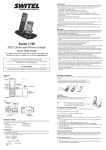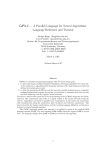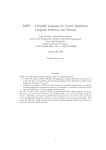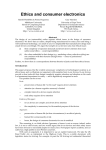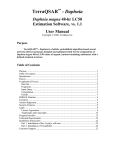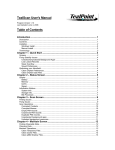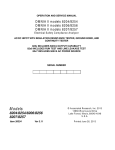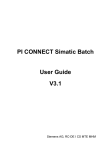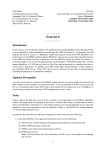Download CuPit-2: Portable and Efficient High
Transcript
CuPit-2: Portable and Efficient High-Level Parallel Programming of Neural Networks Holger Hopp, Lutz Prechelt ([email protected]) Universität Karlsruhe, Fakultät für Informatik, D-76128 Karlsruhe, Germany Phone: +49/721/608-7344, Fax: -7343 12th January 1998 Submission to the Special Issue on ”Simulation of Artificial Neural Networks” for the Systems Analysis Modelling Simulation (SAMS) journal Abstract CuPit-2 is a special-purpose programming language designed for expressing dynamic neural network learning algorithms. It provides most of the flexibility of general-purpose languages such as C or C++, but is more expressive. It allows writing much clearer and more elegant programs, in particular for algorithms that change the network topology dynamically (constructive algorithms, pruning algorithms). In contrast to other languages, CuPit-2 programs can be compiled into efficient code for parallel machines without any changes in the source program, thus providing an easy start for using parallel platforms. This article analyzes the circumstances under which the CuPit-2 approach is the most useful one, presents a description of most language constructs and reports performance results for CuPit-2 on symmetric multiprocessors (SMPs). It concludes that in many cases CuPit-2 is a good basis for neural learning algorithm research on small-scale parallel machines. Keywords: neural networks, parallel programming, portability, compiler, constructive algorithms, pruning. 1 Neural network simulation: Requirements and approaches For simulating artificial neural networks for engineering purposes, there are typically three major requirements for the simulation system: ease of use, high performance (i.e., execution speed), and flexibility. We discuss for which sorts of users which of these requirements are most important, what solutions are available, and what consequences these solutions have: 1. Ease of use. For rapid development of a neural network solution for a given application problem (solution engineering) the most important requirement is often to reduce the amount of human work involved. Hence, the simulation system should allow for simple data handling, training setup and control, and interactive investigation of strengths and weaknesses of alternative networks, algorithms, data encodings etc. for the given problem. Furthermore, the software should be easy to learn. This sort of requirement is usually best handled by integrated neural network simulators such as SNNS [23], Xerion [19], NeuroGraph [22], NeuralWorks [11] etc. These programs package multiple well-known learning algorithms with data manipulation functions and interactive graphical network exploration and manipulation capabilities. They are relatively easy to learn and will often provide the fastest path to a reasonable solution of a given engineering problem. The disadvantages of simulators are limited flexibility and often also suboptimal execution speed: When algorithms beyond the supplied standard ones need to be employed, both ease of use and ease of learning break down, because internal simulator programming is required. Furthermore, integrated simulators rarely provide full access to the fastest means of network execution as discussed in the next paragraph. 2. High execution speed. If the networks required for the given learning problem are very large or there are very many examples, execution speed becomes a dominant factor. In this case, the simulation system must be optimized for exploiting available hardware performance. There are three ways for obtaining fast neural network performance: using machine-dependent, highly optimized libraries for matrix operations, utilizing parallel processors, or employing specialpurpose hardware. All three kinds of solutions (which may be combined) typically either suffer from limited flexibility or lack ease of use. Not all kinds of learning algorithms can be implemented using given matrix libraries or special-purpose hardware, the latter may also suffer from problems with computational precision for some problem domains [20]. On the other hand, general-purpose parallel processors are quite flexible, yet are typically difficult to program. 3. Flexibility. If one is doing research in neural network learning algorithms or very advanced development, standard algorithms and network structures may be insufficient; the same is true if the neural network has to be interwoven (as opposed to interfaced) with other parts of a system. The worst case are learning algorithms that change the topology of the neural network dynamically during the learning process. We call such algorithms constructive algorithms; they may be either additive (adding nodes or connections), subtractive (pruning nodes or connections), or both. Constructive algorithms make network handling very complicated for the simulation system. In this case, most users end up with handwritten programs in conventional programming languages such as C or C++. Sometimes, special neural network libraries such as MUME [6] or Sesame [10] may be used to simplify parts of the programming. Obviously such flexibility requirements impede or even contradict ease of use. Unfortunately constructive algorithms also require immense effort for obtaining high execution speed, because the resulting networks are both irregular and nonstatic; the problem is most pronounced on parallel computers. The present paper presents a simulation system based on a special-purpose programming language, CuPit-2. The system is flexible enough for doing research into constructive learning algorithms, 2 yet allows for exploiting parallel hardware in a machine-independent, portable fashion. Furthermore, the language is problem-oriented and therefore relatively easy to use. The next section discusses the general idea behind our approach. Subsequent sections informally present the CuPit-2 language, its implementations, and benchmark results on symmetric multiprocessor machines. 2 The CuPit-2 approach Our work assumes the following requirements profile: The user wants to perform research or advanced development of learning algorithms that modify the topology of the network during the learning phase (constructive algorithms). To do this, the user will write appropriate simulation programs that implement the new algorithms. The user wants to employ general-purpose parallel computers for (some of) the simulations. The simulation programs must be portable. Their parallel execution should be efficient. The user is not willing to learn machine-dependent or low-level parallel programming constructs in order to write the simulation programs. The goal of our work is to provide a simulation system that fits these requirements well. Obviously none of the simulation systems common today fulfills all three requirements: The available preprogrammed simulators cannot accommodate constructive algorithms, at least not on parallel machines. The same is true for neural network library approaches. Handwritten implementations in standard languages such as C or C++ require low-level parallel programming (data distribution, message passing, work partitioning, thread management, load distribution, etc.) and typically result in non-portable programs. Finally, high-level general-purpose parallel languages (e.g. Concurrent Aggregates [3]) would be acceptable from the programming point of view, but they cannot yet be translated into sufficiently efficient parallel code. Thus we propose to use a special-purpose parallel programming language for neural network learning algorithms. Such a language could be sufficiently simple to learn, because the users understand the abstractions behind its constructs well. It can be made flexible enough to accommodate constructive algorithms, yet would be completely problem-oriented, thus providing portability between various parallel and sequential machines. And it could allow for efficient parallel implementation, because knowledge about the behavior of the programs can be built into the compiler for a special-purpose language. We have designed a language, called CuPit-2, with these properties. CuPit-2 describes networks in an object-centered way using special object types “connection”, “node” and “network”. It has special operations for manipulating network topology and allows for parallel operations by parallel procedure calls at the network, node group, and connection level. 3 Various proposals for network description languages, often with less clear aims, have been made by other researchers, e.g. [2, 8, 7, 9, 21]. Most of these cover only static network topologies and are not full programming languages, thus still exhibit most of the problems of hand-written implementations. The most advanced of the above proposals is CONNECT [8], which represents a mostly complete programming language, but still has only incomplete support for dynamic changes of network topology. 3 CuPit-2 language overview The programming language CuPit-2 [5] views a neural network as a graph of nodes and connections. In the neural network literature, the nodes are often called units or neurons, the connections are often called links or, misleadingly, weights. CuPit-2 is based on the observation that neural algorithms predominantly execute local operations (on nodes or connections), reductions (e. g. sum over all weighted incoming connections) and broadcasts (e. g. apply a global parameter to all nodes). Operations can be described on local objects (connections, nodes, network replicates) and can be performed group-wise (connections of a node, nodes of a node group, replicates of a network, or subsets of any of these). This leads to three nested levels of parallelism: connection parallelism, node parallelism and example parallelism. There is usually no other form of parallelism in neural algorithms, such that we can restrict parallelism to the above three levels without loss of generality. Modifications of the network topology can also be performed in parallel, either by local operations (a node splitting or deleting itself, a connection deleting itself) or by global operations (enlarging or reducing a node group, creating or deleting the connections between two node subgroups). CuPit-2 is a procedural, object-centered language; there are object types and associated operations but no inheritance or polymorphism. The identification of network elements is based on four special categories of object types: connection, node, node group, and network types. A simplified view of the CuPit-2 network model is shown in the example in Figure 1. CuPit-2’s connections are always directed, but that does not restrict the flow of information through them. Fig. 1 !!! This approach makes a wealth of information readily available to the compiler that would be difficult to extract from a similar program in a normal parallel programming language. We use this information to generate efficient parallel and sequential code. The rest of this section will describe the main parts of a CuPit-2 program consisting of connection, node, and network descriptions (including operations) and a main program that controls the algorithm. 3.1 Connections Let us start with an example definition of a connection type that handles weight multiplication and weight pruning. The following declaration defines a connection type Weight for connecting two nodes of type SigmoidNode. More precisely: an OUT interface of a SigmoidNode with 4 an IN interface of another (or the same) SigmoidNode. The node type SigmoidNode and its interfaces will be introduced below. TYPE Weight IS CONNECTION FROM SigmoidNode OUT out; TO SigmoidNode IN in; Real weight := 0.0, delta := 0.0; Real FUNCTION weightMultOutput () IS RETURN ME.weight * out.data; END FUNCTION; PROCEDURE prune (Real CONST threshold) IS IF abs(ME.weight) < threshold THEN REPLICATE ME INTO 0; (* self-delete *) END; END PROCEDURE; (* further connection procedures are not shown *) END TYPE; As mentioned before, connections are always directed, i. e. , there are no connections between A and B, but from A to B, so the compiler can co-locate connection data with node data on the processors of a parallel machine. Nevertheless, data can always be sent along a connection in both directions. The Weight connection object is a structure of two data elements weight and delta of the built-in type Real. Associated with this type are its object functions and procedures. The function weightMultOutput yields the product of the weight with the data element of the connected FROM node (named out, because it is the out interface of the node). ME always designates the object for which the current procedure is being called. The prune procedure implements a local topology modification, namely the conditional selfdeletion of the connection. To delete a connection, the connection replicates itself into 0 copies of itself; the same can be done for nodes including all their connections. Both routines can only be called from nodes that have connections of type Weight attached, as in the following node type example. 3.2 Nodes This is an example definition of a node type that handles forward propagation and connection pruning. TYPE SigmoidNode IS NODE IN Weight in; OUT Weight out; Real data, bias; 5 PROCEDURE forwardHidden () IS Real VAR inData; REDUCTION ME.in[].weightMultOutput():rsum INTO inData; ME.data := activation (inData + ME.bias); END PROCEDURE; PROCEDURE prune (Real CONST threshold, Bool CONST hasoutputs) IS ME.in[].prune (threshold); (* delete hidden nodes that have become unconnected: *) IF hasoutputs AND (MAXINDEX (ME.in[]) < 0 OR MAXINDEX(ME.out[]) < 0) THEN REPLICATE ME INTO 0; END; END PROCEDURE; (* further node procedures are not shown *) END TYPE; The node type SigmoidNode has two data elements, data and bias, and two connection interfaces: in for incoming connections of the above type Weight and out for outgoing connections. Node procedures operate on all connections attached to an interface at once. For instance the node procedure prune calls the connection procedure prune on all connections attached to the in interface of the node. The [] notation stands for “all” and designates parallel calls. The connection procedure prune is executed in asynchronous parallel fashion for every connection. This call realizes nested parallelism, as the node procedure prune itself may be executed for several nodes in parallel as well. To delete a node, the node replicates itself into 0 copies of itself; the same construction is shown above for connections. MAXINDEX returns the number of objects in a compound object, minus one (here: the number of connections attached to a connection interface). The REDUCTION statement in the node procedure forwardHidden combines the results of weightMultOutput of all connections attached to the in interface using the reduction operator rsum, which is defined by the user as Real REDUCTION rsum NEUTRAL 0.0 IS RETURN (ME + YOU); END REDUCTION; The result is written into the variable inData and will be the NEUTRAL value of the reduction operator if there are no connections. The order in which the individual reduction operations (here: additions) are executed is not defined. Arbitrary reduction operators on arbitrary data types can be defined in the above manner and will be translated into efficient parallel tree reduction implementations. The activation function called above is a so-called free subroutine: it is not attached to any object type and can be called from anywhere. 6 3.3 Networks Now we will construct a network of SigmoidNodes and their Weight connections: TYPE Layer Real IO IS GROUP OF SigmoidNode END; xIn, xOut; (* I/O-areas, managed externally *) TYPE Mlp IS NETWORK Layer inL, hidL, outL; Real totError; (* three groups of nodes *) (* total sum squared error *) PROCEDURE createNet (Int CONST inputs, hidden, outputs) IS EXTEND ME.inL BY inputs; (* create input node group *) EXTEND ME.hidL BY hidden; (* create hidden node group *) EXTEND ME.outL BY outputs; (* create output node group *) (* create all input-to-hidden and hidden-to-output connections: *) CONNECT ME.inL[].out TO ME.hidL[].in; CONNECT ME.hidL[].out TO ME.outL[].in; END; PROCEDURE trainEpoch (Int CONST nrOfExamples, repl) IS Int VAR i := 0; (* start example index *) Bool VAR done := false; (* termination indicator *) ME.out[].resetErrors(); (* clear output node error sums *) REPEAT getExamples (xIn, xOut, repl, nrOfExamples, i, INDEX, done); (* procedure is not shown *) ME.inL[].data <-- xIn; (* write input & output coeffs. *) ME.outL[].data <-- xOut; (* into appropriate nodes *) ME.hidL[].forwardHidden (); (* begin forward pass *) ME.outL[].processOutput (); (* forward + backward *) ME.hidL[].backwardHidden (); (* finish backward pass *) UNTIL done END REPEAT; END PROCEDURE; PROCEDURE prune (Real CONST fractionToPrune) IS Real VAR threshold; ME.determinePruningThreshold (fractionToPrune, threshold); (* procedure is not shown *) ME.hidL[].prune (threshold, true); ME.outL[].prune (threshold, false); END PROCEDURE; (* further network procedures are not shown *) END TYPE; The network type Mlp is a simple three layer perceptron consisting of the node groups inL, hidL, outL and a floating point value totError. A node group is a dynamic, ordered set of nodes. The createNet procedure creates the nodes in the groups and the connections between them. Similar operations could also be performed later during the program run. The trainEpoch procedure executes the forward and backward pass through the network for all 7 input/output example pairs. The prune procedure determines the pruning coefficient threshold below which connections are to be removed and then calls the actual pruning operation for each layer of nodes. Note that for brevity the main program given below does not call prune at all. The individual data values for the example are brought into the network by the <-- operations via so-called I/O-areas. This mechanism is required because, on one hand, the memory layout of the input nodes may be complicated and may change several times during program execution, but, on the other hand, the actual input operations for reading examples from files need to rely on a particular memory layout for delivering their data. I/O-areas act as mediators. 3.4 Main Program The following presents a partial main program: Mlp VAR net; (* THE NETWORK *) PROCEDURE program () IS Int VAR epochNr := 0; Real VAR error; net[].createNet (inputs, hidden, outputs); REPLICATE net INTO 1...maxReplicates; REPEAT epochNr += 1; net[].trainEpoch (nrOfExamples, MAXINDEX(net)+1); MERGE net; (* sum weight changes from all replicates *) net[].adapt; (* modify weights *) net[].computeTotalError(); (* sum errors over output nodes *) error := net[0].totError; maybePrune(epochNr); UNTIL (error <= stoperror) OR (epochNr >= maxEpochs) END REPEAT; REPLICATE net INTO 1; (* merge, then remove replicates *) END PROCEDURE; The statement REPLICATE net INTO 1...maxReplicates requests network replication in order to exploit parallelism over examples. The compiler or run time system can choose how many replicates to actually use for fastest execution; any number in the range 1 to maxReplicates is allowed. During training, the replicates will diverge in their data values but not in their network topology, since topology modifications are forbidden while a network is replicated. To synchronize data in replicates, the program calls MERGE net, which executes type-specific user-defined merge operations in all objects. In the above program, merging is only required for the delta values in the connections just before the weight update step. MERGE IS ME.delta += YOU.delta; END MERGE; 8 Merging is realized by including the definition shown besides in the type Weight. All other management of network replicates is implicit and provided by the compiler. To perform topology changes on the network, one must reunite the replicates into just one network by the call REPLICATE net INTO 1, which also performs a merge first. For example, a simple (nonrealistic) pruning control scheme in the main program could be PROCEDURE maybePrune (Int CONST epoch) IS IF (epoch % 50 = 0) AND (epoch >= 100) THEN REPLICATE net INTO 1; net[].prune(0.1); REPLICATE net INTO 1...maxReplicates; END; END PROCEDURE; The REPLICATE operation also automatically rearranges and compactifies the memory layout (on all types of computers) and reoptimizes the data distribution (on distributed memory parallel computers only). 3.5 Persistence of networks The CuPit-2 language provides operations for input and output of complete networks in different file formats. This has two consequences: First, it supports persistent storage of networks and, second, it allows to transfer networks between CuPit-2 and other systems. Currently only one network file format is supported: the network format used by the SNNS [23] simulator. This means for instance that a network produced by a CuPit-2 program can be written to a file, read into the SNNS simulator, and analyzed using its graphical interface. The results could be further trained by a CuPit-2 program etc. For storing/reading a network only a single net[].fwrite() or net[].fread() call is required. However, the semantics of these calls must be defined by the user by additional specifications in each connection, node, or network type definition. First the operation type and file format needs to be selected, e.g. IOSPEC fwrite IS STYLE snns KIND fileoutput END; This defines an output procedure fwrite, which uses the library-defined snns style. The fields of a connection, node, or network that should be written to the file are specified by short I/O specifications. For example in the connection type definition we may write IOSPEC fwrite IS ME.weight; END; The declaration defines that the CuPit-2 connection element weight is to be written out, all other elements will be ignored. Similar simple specifications must be defined for nodes and networks 9 in order to store other data and the network topology. The latter is represented by writing node groups and connection interfaces. This persistence mechanism provides a smooth integration of CuPit-2 with other neural network simulation tools. 3.6 Other Features Some topology modification statements are not shown in the above program: DISCONNECT (inverse of CONNECT), node self-cloning (e. g. REPLICATE ME INTO 3, which triplicates the node and all its connections), and node deletion using negative arguments to EXTEND. Subsets of node groups (or connection interfaces) can be accessed using a slice notation, e.g. net.outL[2...5].data --> xOut would output the data value from only the node group slice consisting of nodes 2 to 5 of outL into the I/O area xOut. The same notation can be used in CONNECT statements and parallel procedure calls. Furthermore, it must be mentioned that CuPit-2 is a complete programming language. Common constructs such as array, record, and enumeration data types, or while and for loops etc. are also available in CuPit-2. Finally, it is possible to incorporate program parts written in other languages such as C. 4 Implementations and performance results We have implemented prototype compilers for the massively parallel MasPar MP-1/MP-2 [14, 15] (this compiler implements the language CuPit [12, 16], which is very similar to CuPit-2), for sequential computers, and for symmetric multiprocessors (SMP). We focus on the sequential and SMP compilers here. 4.1 Basic performance: node vs. example parallelism For simple feed-forward algorithms (backprop, rprop) the performance of sequential code is a little better than the SNNS simulator [23]. CuPit-2 is about 10% to 100% faster than SNNS on Sun SuperSPARC or HyperSPARC, and about the same speed (5%) on DEC Alpha systems. The performance gain increases for algorithms performing connection pruning. In contrast to the MasPar compiler, the implementation on SMPs never uses connection parallelism, but makes use of as much example parallelism (network replicates) as allowed. If there is more than one processor per network replicate, node parallelism will be used. Our results show performance variation depending on the size of the network: Example parallelism is bad for networks larger than the cache, see Figure 2. The figure shows RPROP [18] performance expressed Fig. 2 !!! in “Million Connection Updates Per Second” (MCUPS) for a large network (SNNS version of nettalk, 203+120+26 nodes, 27480 connections, 200 patterns). The poor example-parallel performance on the HyperSPARC system occurs because this network does not fit in the 256KB 10 local processor cache and cache misses are quite expensive on this architecture. Using only node parallelism is much better in this case. Figure 3 shows RPROP performance for a small network (vowel recognition, 9+20+3 nodes, 240 Fig. 3 !!! connections, 5453 patterns). In this case the network is too small to use node parallelism efficiently, but example parallelism is quite efficient. 4.2 Performance with pruning algorithms However, the point of CuPit-2 is not executing plain learning algorithms, but those that modify the topology of the network during learning. To investigate the performance in this case, we perform some benchmarks with the autoprune learning algorithm [4]. This algorithm removes some fixed fraction of the connections when overfitting is detected during training. Training then proceeds with the thus pruned network. The connections to be removed are those that rank lowest on a measure of connection importance defined by the algorithm. autoprune removes 35% of all connections in the first pruning step, and 10% of the remaining connections in each subsequent pruning step. With a system that does not support pruning, the performance would decrease after pruning: Pruned weights would just be fixed at zero, the program would still require the same run time per epoch, but perform less and less actual work. Figure 4 shows how the execution speed using example parallelism changes during pruning. Per- Fig. 4 !!! formance for two problems is shown, both measured on the HyperSPARC machine. The first is the nettalk problem shown above (with 203+120+26 nodes and 32758 connections initially). The other is the soybean1 data set taken from the Proben1 benchmark set [13] (with 83+16+8+19 nodes and 4153 connections initially). See [13, 17] for details of the data and algorithm setup. As we see, the nettalk problem initially shows rather low performance. As discussed above, this is because the network is too large to fit into the processor cache. The performance is even lower than in the RPROP measurement above because the autoprune algorithm performs more work and requires more data. However, as more and more of the network is pruned, performance increases, because increasingly more of the network fits into the cache. The strong fluctuations are due to pseudo-random cache conflicts that are more frequent in some memory layouts during pruning than in others. Cache misses are particularly expensive on the HyperSPARC machine used, yet its cache is only one-level and only one-way associative. The downward outliers in the four processor run are due to other processes active on the machine at the same time. After some point (at roughly epoch 620 in the 4-processor case) performance decreases again, but only slightly so. The decrease is unavoidable as less parallelism is available in the ever smaller network, hence the sequential part (reading examples etc.) consumes an increasing fraction of the run time. The soybean problem is different in that is fits into the cache from begin on. Therefore, we observe a steady decrease of performance with each subsequent pruning step. The decrease is more pronounced than for nettalk because the soybean network is much smaller and thus the sequential part of the run time is larger. 11 Are these results any good? Remember that the goal of CuPit-2 is to reduce the run time per epoch in proportion the decreasing amount of actual (i.e., useful) work done per epoch. There are two situations with which we might compare the above results: First, what would happen if pruning was realized by just setting weights to zero or, second, what performance does a smaller (regular) network have compared to our pruned (irregular) one with the same number of connections? In the nettalk run on four processors, the network is pruned from 32758 connections in epoch 0, running at 1.03 MCUPS, down to 811 connections in epoch 1179, running at 3.06 MCUPS. That is, 97.5% of all connections are removed1 and thus without physical pruning the performance could be at most 2.5% of the initial value, namely 0.025 MCUPS, which is 120 times slower than CuPit-2! The actual performance of the final CuPit-2 network is even somewhat better than a fully connected, regular nettalk network of similar size (3 (or 4) hidden nodes, no shortcut connections, 713 (or 916) weights, 2.26 (or 2.69) MCUPS). In the soybean run on four processors, the network is pruned from 4153 connections in epoch 0, running at 7.54 MCUPS, down to 769 connections in epoch 2444, running at 4.49 MCUPS. That is, 81.5% of all connections are removed and thus without physical pruning the performance could be at most 18.5% of the initial value, namely 1.40 MCUPS, which is 5.4 times slower than CuPit2. The actual performance of the final CuPit-2 network is equal to a fully connected, regular soybean network of similar size (5+2 hidden nodes, no shortcut connections, 743 weights, 4.45 MCUPS), i.e., as good as possible. The nettalk performance could be further improved if the compiler would automatically switch between node parallelism and example parallelism (starting with node parallelism until the network becomes small enough). This is not currently implemented, but can be enforced explicitly by the CuPit-2 program if necessary. 5 Conclusion CuPit-2 offers several advantages as a platform for neural learning algorithm research. Its high expressiveness for neural network constructs results in simpler and more readable programs than general purpose languages such as C/C++could provide. The difference becomes most pronounced for algorithms that modify the structure of the neural network dynamically, because CuPit-2 provides special constructs for topology changes. Our performance measurements show that CuPit-2 run time performance is similar to other sequential simulation systems. Furthermore, the same performance is realized even for irregular networks such as those resulting from connection pruning. The most interesting point of CuPit-2 is that all of these advantages carry over to parallel implementations without any source code changes. In particular, we know of no other NN simulation system that supports all kinds of dynamic topology changes on parallel machines, let alone maintains its parallel performance for irregular networks. Our results suggest that CuPit-2 is a reasonable basis for small-scale parallelism in neural networks research. 1 Note that the best network typically occurs long before this final one during training. 12 However, CuPit-2 is no panacea. If the algorithm is not sufficiently parallelizable at all or if the program hides the parallelism, the compiler will not be able to produce efficient parallel code. Similarly, if the problem at hand is too large or too small for the given machine, run time performance suffers as with any other system. On the other hand, it may sometimes be worthwhile to use CuPit-2 just for its high expressiveness even if no use of parallel machines is planned. More information on the language and its implementations can be found at the CuPit-2 web page http://wwwipd.ira.uka.de/˜hopp/cupit.html. References [1] 15th IMACS World Congress on Scientific Computation, Modelling, and Applied Mathematics, 1997. [2] Nikolaus Almássy. Ein Compiler für CONDELA-III. Master’s thesis, Institut für praktische Informatik, TU Wien, February 1990. [3] Andrew A. Chien. Concurrent Aggregates: Supporting Modularity in Massively-Parallel Programs. MIT Press Cambridge, Massachusetts, London, England, 1993. [4] William Finnoff, Ferdinand Hergert, and Hans Georg Zimmermann. Improving model selection by nonconvergent methods. Neural Networks, 6:771–783, 1993. [5] Holger Hopp and Lutz Prechelt. CuPit-2: A parallel language for neural algorithms: Language reference and tutorial. Technical Report 4/1997, Fakultät für Informatik, Universität Karlsruhe, Germany, mar 1997. [6] Marwan Jabri, Edward Tinker, and Laurens Leerink. MUME: An environment for multi-net and multi-architectures neural simulation. Technical report, System Engineering and Design Automation Laboratory, University of Sydney, NSW 2006, Australia, 1993. [7] Gerd Kock and Thomas Becher. Mind: An environment for the development, integration, and acceleration of connectionist systems. In [1], pages 499–504, 1997. [8] Gerd Kock and N.B. Serbedzija. Artificial neural networks: From compact descriptions to C++. In Proceedings of the International Conference on Artificial Neural Networks, 1994. [9] Russel R. Leighton. The Aspirin/MIGRAINES neural network software, user’s manual, release v6.0. Technical Report MP-91W00050, MITRE Corp., October 1999. [10] Alexander Linden and Christoph Tietz. Combining multiple neural network paradigms and applications using SESAME. In Proc. of the Int. Joint Conf. on Neural Networks, Baltimore, June 1992. IEEE. [11] NeuralWorks Reference Guide, NeuralWare Inc. http://www.neuralware.com/. [12] Lutz Prechelt. CuPit — a parallel language for neural algorithms: Language reference and tutorial. Technical Report 4/94, Fakultät für Informatik, Universität Karlsruhe, Germany, January 1994. Anonymous FTP: /pub/papers/techreports/1994/1994-04.ps.gz on ftp.ira.uka.de. 13 [13] Lutz Prechelt. PROBEN1 — A set of benchmarks and benchmarking rules for neural network training algorithms. Technical Report 21/94, Fakultät für Informatik, Universität Karlsruhe, Germany, September 1994. Anonymous FTP: /pub/papers/techreports/1994/199421.ps.gz on ftp.ira.uka.de. [14] Lutz Prechelt. The CuPit compiler for the MasPar — a literate programming document. Technical Report 1/95, Fakultät für Informatik, Universität Karlsruhe, Germany, January 1995. ftp.ira.uka.de. [15] Lutz Prechelt. Data locality and load balancing for parallel neural network learning. In Emilio Zapata, editor, Proc. Fifth Workshop on Compilers for Parallel Computers, pages 111–127, Malaga, Spain, June 28-31, 1995. Dept. of Computer Architecture, University of Malaga, UMA-DAC-95/09. [16] Lutz Prechelt. A parallel programming model for irregular dynamic neural networks. In W.K. Giloi, S. Jähnichen, and B.D. Shriver, editors, Proc. Programming Models for Massively Parallel Computers, page ?, Berlin, Germany, October 1995. GMD First, IEEE CS Press. by accident the article was not printed in the proceedings volume, but see http://wwwipd.ira.uka.de/ prechelt/Biblio. [17] Lutz Prechelt. Connection pruning with static and adaptive pruning schedules. Neurocomputing, 16:49–61, 1997. [18] Martin Riedmiller and Heinrich Braun. A direct adaptive method for faster backpropagation learning: The RPROP algorithm. In Proc. of the IEEE Intl. Conf. on Neural Networks, pages 586–591, San Francisco, CA, April 1993. [19] Drew van Camp. A users guide for the Xerion neural network simulator version 3.1. Technical report, Department of Computer Science, University of Toronto, Toronto, Canada, May 1993. [20] Sven Wahle. Untersuchungen zur Parallelisierbarkeit von Backpropagation-Netzwerken auf dem CNAPS Neurocomputer. Master’s thesis, Fakultät für Informatik, Universität Karlsruhe, Germany, October 1994. [21] Alfredo Weitzenfeld. NSL — neural simulation language. In Proceedings of the International Workshop on Artificial Neural Networks, number 930 in LNCS, pages 683–688, Malaga-Torremolinos, Spain, June 1995. Springer. [22] Peter Wilke and Christian Jacob. The NeuroGraph neural network simulator. In Proceedings of MASCOTS’93, San Diego, CA, 1993. [23] Andreas Zell, Günter Mamier, Michael Vogt, Niels Mache, Ralf Hübner, Sven Döring, KaiUwe Herrmann, Tobias Soyez, Michael Schmalzl, Tilman Sommer, Artemis Hatzigeorgiou, Dietmar Posselt, Tobias Schreiner, Bernward Kett, Gianfranco Clemente, and Jens Wieland. SNNS User Manual, Version 4.1. Technical Report 6/95, Universität Stuttgart, Institut für parallele und verteilte Höchstleistungsrechner, November 1995. 14 node group network OUT interface node IN interface connection Figure 1: Terminology of the CuPit-2 network model 15 Example parallelism 10 Alpha 21064A, 275 MHz HyperSPARC, 100MHz SuperSPARC, 60MHz MCUPS 8 6 4 2 0 0 1 2 3 processors 4 5 Node parallelism 10 Alpha 21064A, 275 MHz HyperSPARC, 100MHz SuperSPARC, 60MHz MCUPS 8 6 4 2 0 0 1 2 3 processors 4 Figure 2: SMP performance on a large network 16 5 Example parallelism 10 Alpha 21064A, 275 MHz HyperSPARC, 100MHz SuperSPARC, 60MHz MCUPS 8 6 4 2 0 0 1 2 3 processors 4 5 Node parallelism 10 Alpha 21064A, 275 MHz HyperSPARC, 100MHz SuperSPARC, 60MHz MCUPS 8 6 4 2 0 0 1 2 3 processors 4 Figure 3: SMP performance on a small network 17 5 5 4 processors 2 processors 1 processor MCUPS 4 3 2 1 0 0 200 400 600 Epoch 800 1000 1200 9 4 processors 2 processors 1 processor 8 7 MCUPS 6 5 4 3 2 1 0 0 500 1000 1500 Epoch 2000 2500 Figure 4: SMP performance using 1, 2, or 4 processors for a large network (nettalk, top figure) or smaller network (soybean, bottom figure) during the execution of a pruning algorithm. The horizontal axis shows the training epochs. 18


















